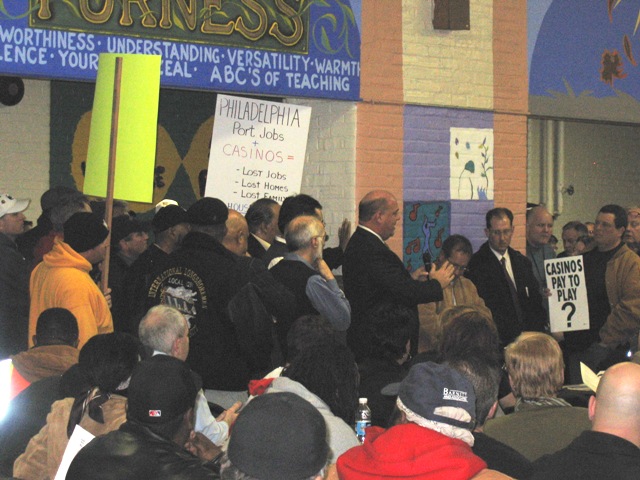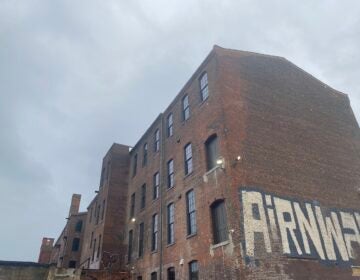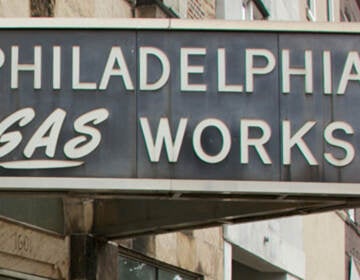South Philadelphia: final forum

Feb. 20
Residents angry about port future, casinos. See Voices. See Protest. Video1 Video2
Tuesday night, the final public forum in an exercise geared to help world-class designers and planners start to create a new vision for seven miles of the Central Delaware Riverfront began with 100 placard carrying longshoremen protesting outside of Furness High School against casino sites in Northern Liberties and South Philadelphia.
Then, in what can only be described as civic engagement South Philly style, a boisterous crowd of 300 port workers and their family members voiced their severe displeasure with the timing of the planning process, the city administration, their state senator and the governor before eventually settling down to the loud, hard and contentious work of trying to define what they want their section of the waterfront to be.
In an orchestrated protest that benefitted from a rehearsal the day before that got 300 people out of bed at 6 a.m., citizens and International Longshoremen Association officials made it clear that they would not engage is any discussion about planning their riverfront’s future until facilitators for the Central Delaware Riverfront Planning Process agreed to carry their message back to legislative decision makers.
The Protests
Like the principle sessions held earlier in Society Hill and Kensington, it was clear that many residents were concerned about issues such as the viability of the working port, traffic and the potential development of two casinos on the Delaware River. Unlike previous sessions, most of the assembled Tuesday night were vehement about keeping the discussion squarely centered on the negative impact casinos would have on their neighborhoods.
The facilitators for this process: PennPraxis director Harris Steinberg of Penn’s School of Design and Harris Sokoloff, an expert in civic engagement with the Penn Graduate School of Education, said they support everyone who voiced a concern staying with this open planning process, no matter their viewpoint, and both said citizens should use what they learned about values in these forums to make their personal cases and arguments about what the riverfront should be. Both made it clear the planning process was not a “sham” or shoehorn for casinos.
Steinberg also said this process is a once-in-a-lifetime way to capture and use the voice of the people to help lay the foundation for creating a lasting vision for that waterfront.
“There is a lot more development happening or potentially happening on the Delaware besides casinos. This process is not about taking a stand on casinos. It’s about reflecting the best way to re-vision the Delaware Riverfront as a whole.”
International Longshoremen’s Vice President James Paylor, Jr., said he felt the planning process, while good intentioned, had not had the advantage of being fully informed about political machinations that would adversly affect his constituents. He did encourage the assembled residents to allow the planning process to proceed and allow it to carry their message back to Harrisburg.
While most of the attendees carried on a spirited, talk-show style give-and-take with Sokoloff, 30 participants broke off for a more traditional interaction, interviewing each other by asking a question about what each value represented in terms of broadly framing a set of design parameters for the waterfront.
The “reporter’s” task was to try to understand the other person’s views as richly and clearly as possible and to record them briefly and accurately. Later the group as a whole synthesized ideas with others who asked the same question.
The value questions posed Tuesday night in order to establish design principles were:
A safe place to live: Please tell a story that describes your experience with the waterfront and the neighborhoods being a safe place to live, work and play. What does your story suggest about what could or should be done to preserve or improve this value?
Varieties of diversity and culture: Please tell a story that describes your experience with variety of diversity and culture on the waterfront and the neighborhoods. What does your story suggest about what could or should be done to preserve or improve this value?
Economic sustainability: Please tell a story that speaks to you about the importance of the waterfront economy. What does your story suggest about what could or should be done to preserve or improve this value?
The Environment: Please tell me a story about a time when you were able to appreciate the value of a clean and open environment along the waterfront. What does your story suggest about what could or should be done to preserve or improve this value?
History: Please tell a story about a time when you had a meaningful experience of Philadelphia’s history along the waterfront. What things could have been improved to make your experience of that history more meaningful does your story suggest about what could or should be done to preserve or improve this value?
When answering the questions, participants were urged to draw on their hopes and dreams for the waterfront.
The principles that were identified are, in effect, guidelines for the development of the civic vision for the waterfront. They inform and tell the planning and design teams the kinds of things to include in the plan and they will be used in the March 1-3 design charrettes.
As a reference, some of the principles that surfaced Feb. 12 in Society Hill were:
a river trail like the one on the Schuylkill;
development and parks that overlook the water;
space for unprogrammed river recreation;
a living history adjunct to the Seaport Museum;
transit opportunities that allow for easy riverfront access;
a beach at river’s edge;
safety in numbers of people using the waterfront;
increased access because of proper lighting;
fishing piers that bring people to the water.
Compare those to some of the principles that surfaced during the Kensington forum:
Better stormwater management through water features;
An improved storm sewer system that does not pollute the river;
Permeable pavement;
Swimming pools at river’s edge;
A variety of many different ideas for the waterfront: cruise ships, small shops, restaurants;
Street easements that allow access to the river from neighborhoods;
Murals under I-95;
A plan that takes into account global warming;
Sculpture gardens;
And this is how they stack up with some major principles that came out of the South Philadelphia forum Tuesday:
Affordable senior housing:
Dredging for more shipping potential;
Build a larger port;
Find a way for commercial and residential uses to coexist;
Let neighborhoods control piers;
More and better recreational facilities;
Get rid of bus traffic;
Create excellent schools;
Give working people of Philadelphia voice in the process:
Change out the politicans;
Protect tradition, like working port jobs.
Penn Praxis’ Steinberg was pleased with the passion he witnessed Tuesday night.
“This is what a civic engagement process is about. This is what we want to see. I am extremely happy with how the evening played out.”
More coverage, including a video of the event, Wednesday on www.planphilly.com
WHYY is your source for fact-based, in-depth journalism and information. As a nonprofit organization, we rely on financial support from readers like you. Please give today.






